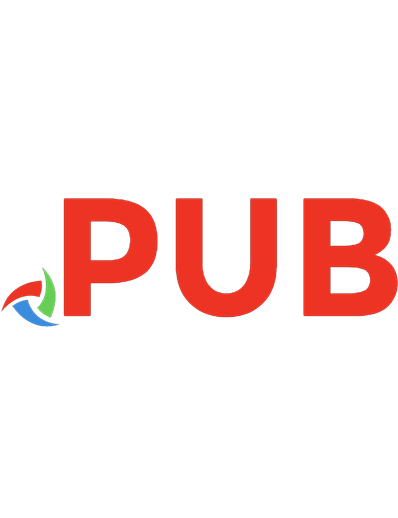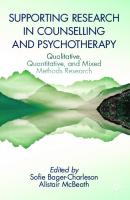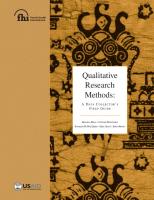The Handbook Of Teaching Qualitative And Mixed Research Methods: A Step-By-Step Guide For Instructors [1 ed.] 1032100230, 9781032100234, 1032100273, 9781032100272, 100380960X, 9781003809609, 1003809553, 9781003809555, 9781003213277
The Handbook of Teaching Qualitative and Mixed Research Methods: A Step-by-Step Guide for Instructors presents diverse p
160 49 3MB
English Pages 373 Year 2024
![The Handbook Of Teaching Qualitative And Mixed Research Methods: A Step-By-Step Guide For Instructors [1 ed.]
1032100230, 9781032100234, 1032100273, 9781032100272, 100380960X, 9781003809609, 1003809553, 9781003809555, 9781003213277](https://dokumen.pub/img/200x200/the-handbook-of-teaching-qualitative-and-mixed-research-methods-a-step-by-step-guide-for-instructors-1nbsped-1032100230-9781032100234-1032100273-9781032100272-100380960x-9781003809609-1003809553-9781003809555-9781003213277.jpg)
- Author / Uploaded
- Alissa Ruth
- Amber Wutich
- H. Russell Bernard
- Categories
- Education
- Commentary
- TruePDF | Full TOC
Table of contents :
Cover
Half Title
Title Page
Copyright Page
Table of Contents
Acknowledgments
List of Contributors
Introduction
Section 1 Research Ethics
1 Teaching Ethics in Qualitative Research
2 Obtaining Consent: Why, What, and How
Section 2 Sampling in Qualitative Research
3 Teaching Qualitative Sample Size Estimation
4 Non-Probability Sampling
5 Collecting Data from Networked Populations: Snowball and Respondent-Driven Sampling
6 Sampling Design for Qualitative Research: Teaching Theoretical Sampling for Cross-Cultural Research
Section 3 Interviews as Data Collection
7 Teaching Interviewing: How to Guide Conversations for Qualitative Research
8 Cognitive Interviewing for Questionnaire Design and Evaluation
9 Ethnographic Interviewing: The Life of Language among Families
10 Free List Interviewing
11 Qualitative Interviewing in the Study of Culture
12 Personal Network Analysis
13 A Strategy to Practice Moderating in Focus Groups
14 Focus Group Interviewing Method
Section 4 Observations as Data Collection
15 Participant Observation: How to Be a Participant and Observer at the Same Time
16 Observation as Data Collection
17 How Behavior Observations Enrich Qualitative Researchers
18 Ethnography: A First Overarching Look
19 Rapid Ethnographic Assessment
20 Teaching Field Notes
21 Ethnographic Writing
22 Teaching Reflexivity and Positionality
23 Autoethnography: Sensitizing the “I”
24 Social Media Data Analysis
25 Shooting Video for Social Science Research
Section 5 Indigenous and Decolonizing Methods
26 A Brief Introduction to Critical Indigenous Research Methodologies
27 Ethically Engaging Marginalized Communities in Research
28 Talanoa Research Methodology: Strategies for Teaching an Indigenous Methodology
29 Centering Indigenous Practice: Talking Circles as Participatory Action Research
30 Indigenous Data Sovereignty and Governance
31 A Black Feminist Life History Method: How to Center Black Women’s Voices
32 Sister–Girl Talk: A Method for Group Interviewing Black Women
33 Community-Engaged Partnership Research
34 Theater as Ethnographic Method
Section 6 Visual and Participatory Methods
35 Photovoice and Participatory Visual Elicitation Methods
36 Teaching Ethnographic Photovoice as a Method for Studying Marginalized Groups
37 Digital Storytelling as a Tool for Critical Narrative Research
38 Introduction to Interactive 3D e-Participatory Methods through the Lens of Urban Planning Projects
39 Art-Based Methods for Qualitative Research with Younger Children
40 Reflecting on Place: Group Sketch Mapping
Section 7 Building Blocks and Basics of Analysis
41 Transcription: Understanding Its Analytical Power
42 Handling Multilingual Data: Transcription and Translation
43 Teaching Theme Identification
44 Finding Themes Using the Cutting and Sorting Approach: Guided Exercises with Interview Data
45 Creating Visual Variables: A First Step in Systematic Analysis of Videotaped Data
46 Developing a Codebook for a Case Participant
47 Coding in Action: Applying Codes at Various Levels
48 Teaching Intercoder Reliability Assessment
49 Teaching Qualitative Content Analysis
50 Context Matters: Conducting Word-Based Analysis in Qualitative Research
Section 8 Grounded Theory, Phenomenology, and Narrative Analysis
51 Doing Grounded Theory: Key Steps for Design, Data Collection, and Analysis
52 Phenomenological Interpretation: Creative Lesson on Lived Experience
53 Narrative Analysis
54 Narrative Analysis: The Narrated, Non-Narrated, and the Disnarrated
55 Meaning and Idioms in Life History Narratives
Section 9 Linguistic Analysis
56 Corpus Linguistics and Its Role in Qualitative Research
57 Teaching about Variation
58 Analyzing Language as Actions-in-Interaction
59 Teaching Indexicality through a Focus on Identity
60 Teaching Discourse Analysis Using Political Texts
61 Using Critical Discourse Analysis to Understand Texts in Context
Section 10 Network Analysis and Cultural Domain Analysis
62 Mixed Semantic Network Analysis to Explore Discoursive and Cultural Landscapes
63 Walking in Your Footsteps: Using Qualitative Methods in Whole Network Analysis
64 Mapping the Structure of a Cultural Domain: Cultural Domain Analysis
65 Measuring Cultural Consonance
Section 11 Modeling and Comparative Analyses
66 Topic Models: Modeling from Text Corpora
67 Agent-Based Modeling in Mixed Methods Research
68 Teaching Meta-Themes: A Mixed Methods Approach
69 Teaching Comparative Ethnography: Two Examples from the Environmental Governance Field
70 Uncovering Causal Complexity with Qualitative Comparative Analysis
71 Concepts before Numbers: Teaching Effective Calibration Practices for Qualitative Comparative Analysis
Index

![Activities for Teaching Statistics and Research Methods: A Guide for Psychology Instructors [1 ed.]
143382714X, 9781433827143](https://dokumen.pub/img/200x200/activities-for-teaching-statistics-and-research-methods-a-guide-for-psychology-instructors-1nbsped-143382714x-9781433827143.jpg)


![Social Research Methods: Qualitative, Quantitative and Mixed Methods Approaches [1 ed.]
1526441233, 9781526441232](https://dokumen.pub/img/200x200/social-research-methods-qualitative-quantitative-and-mixed-methods-approaches-1nbsped-1526441233-9781526441232.jpg)


![Counseling research: quantitative, qualitative, and mixed methods [1st ed]
9780131757288, 0131757288](https://dokumen.pub/img/200x200/counseling-research-quantitative-qualitative-and-mixed-methods-1st-ed-9780131757288-0131757288.jpg)
![Research Design: Qualitative, Quantitative, and Mixed Methods Approaches [5 ed.]
9781506386706](https://dokumen.pub/img/200x200/research-design-qualitative-quantitative-and-mixed-methods-approaches-5nbsped-9781506386706.jpg)
![Research Design: Qualitative, Quantitative, and Mixed Methods Approaches [6 ed.]
9781071817940, 9781071817971, 9781071817964, 9781071817957](https://dokumen.pub/img/200x200/research-design-qualitative-quantitative-and-mixed-methods-approaches-6nbsped-9781071817940-9781071817971-9781071817964-9781071817957.jpg)